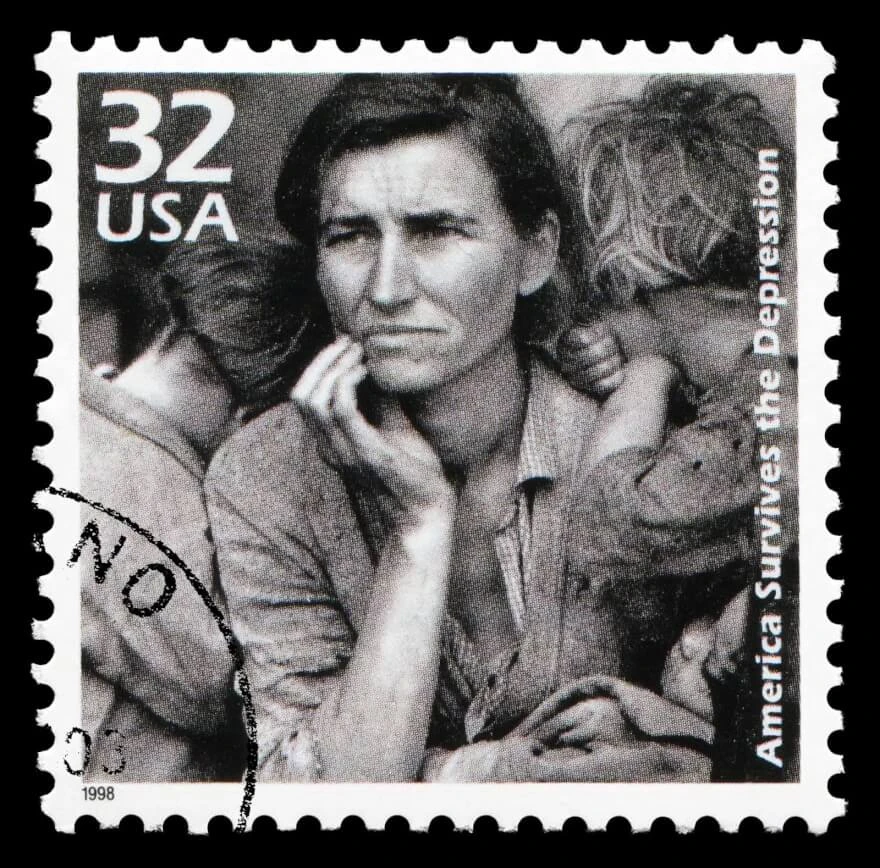Dorothea Lange: greatest documentary photographer

- Biography of Dorothea Lange
- Defining Dorothea Lange's Legacy
- Techniques and Approach
- Photographic Styles
- Documentary and Social Realism Approach
- Portraiture Style
- Landmark Projects
- Impact on Social Reform
- Actions taken during Lange’s work for FSA
- Challenges Faced
- Educational Contributions
- Artistic Evolution
- Exhibitions and Retrospectives
- A Visual Life
- American Photographs
- The Photographer and the Reserve
- Politics of Seeing
- Words & Pictures
- Legacy and Recognition
- Quotes and Philosophy
- “Photography takes an instant out of time, altering life by holding it still”
- “The camera is an instrument that teaches people how to see without a camera”
- “The contemplation of things as they are, without error or confusion, without substitution or imposture, is in itself a nobler thing than a whole harvest of invention”
- “To know ahead of time what you're looking for means you're then only photographing your own preconceptions, which is very limiting, and often false”
- Conclusion
Photography has a long history that dates back to the 19th century. The term was first coined in 1839 and would have made little sense had it not been for the famous photographers of those times. Today we will talk about such a wonderful photographer as Dorothea Lange. We will discuss her biography, how she started out as a photographer, and what her career brought to photography showcased by Dorothea Lange's famous photos and exhibitions.
Biography of Dorothea Lange
Dorothea Lange was born on May 26, 1895 in Hoboken, New Jersey. Her original name was Dorothea Nutzhorn before she adopted her mother’s maiden name after her father, Heinrich Nutzhorn, abandoned the family when Dorothea was 12 years old.
Dorothea Lange photograph’s career started at the age of 22 in New York City’s Greenwich Village where she studied at the Clarence H. White School of Photography. A year later she moved to San Francisco where opened her portrait studio which defined one of her styles. Her career took a dramatic turn during the Great Depression when she witnessed the plight of the unemployed and homeless in the streets of San Francisco. This experience provided a future impact on social reform and made her a documentary photographer for the most part.
Defining Dorothea Lange's Legacy
Let us define what Dorothea Lange’s legacy has brought to photography, what challenges she faced during her career, and how that resonated with society. We go through her photography styles, techniques, and approach, and see where it leads to the present day.

Techniques and Approach
Lange's compositions were carefully crafted to convey the essence of her subjects and their surroundings. She had a keen eye for capturing powerful and evocative images, often using framing and composition to draw attention to key elements within the frame and create a sense of intimacy and connection with her subjects.
Photographic Styles
Dorothea Lange's photographic style can be characterized by its documentary approach and its emphasis on capturing the human experience with empathy and dignity which reflected upon her career dramatically. She focused on the individual stories and experiences of the people she photographed. This empathy allowed her to create images that resonated emotionally with viewers and helped to evoke empathy and understanding for her subjects. She depicts the realities of life, especially the struggles of the working class and marginalized communities. Her images showcase social injustice during the Great Depression era.
Documentary and Social Realism Approach

She took a documentary approach which aimed to provide a truthful and authentic representation of the subjects and scenes she photographed. She often worked in a straightforward and unobtrusive manner, allowing the reality of the moment to speak for itself without embellishment or manipulation. In that era, photography was more about the documentary itself and not the part of art with photo editing apps that we have these days. It was more about photojournalism which Dorothea Lange catered to.
Portraiture Style

Besides being a documentary photographer, Dorothea Lange was also a skilled portrait photographer. Her portraits often captured the character and personality of her subjects, revealing their inner thoughts and emotions. Whether photographing migrant workers, children, and prominent figures or capturing all of that in family photos, Lange approached portraiture with the same empathy and humanity that characterized her documentary work.
Landmark Projects
In the 1930s, Lange began working for the Farm Security Administration (FSA), a government agency created to combat rural poverty during the Depression. It was during this time that she produced some of her most iconic and influential work. Her photographs captured the struggles of migrant workers, sharecroppers, and displaced families, providing a powerful visual record of the human suffering caused by economic hardship.

Dorothea Lange's most famous work, "Migrant Mother," taken in 1936, depicts Florence Owens Thompson, a migrant worker and mother of seven, during the Great Depression. The image became an iconic symbol of the era's hardships and remains one of the most recognizable photographs in American history.
Impact on Social Reform
Lange's photographs brought attention to the struggles of those affected by the Great Depression, including migrant workers, sharecroppers, and displaced families. Her images provided a visual record of the economic hardships and human suffering of the time, reaching a broad audience and fostering empathy and understanding. This in turn shaped public opinion and perception of social issues prompting viewers to reconsider their attitudes towards poverty, labor rights, and social inequality.

Actions taken during Lange’s work for FSA
The mentioned earlier work for the FSA contributed to the government's efforts to address rural poverty and economic hardship during the Great Depression. Her photographs were used to advocate for policies and programs aimed at providing relief to struggling communities, including agricultural assistance, resettlement programs, and labor reforms.
Challenges Faced
In addition to being abandoned by her own father, she also had polio in 1918 which left her with a permanent limp. Despite that physical disability, she continued to pursue her passion for photography, adapting her approach to accommodate her condition.
Moreover, as a woman working in a male-dominated field, Lange faced gender discrimination throughout her career. Despite her talent and dedication, she encountered barriers to advancement and recognition, particularly in the early 20th century when women's roles in professional fields were limited.
Dorothea Lange also faced economic challenges like many artists during the early years of her career. However, despite all these challenges, she remained committed to using her photography as a tool for social change and advocacy.
Educational Contributions

Lange was a vocal advocate for photography education and the importance of visual literacy. She believed that photography could be a powerful tool for social change and advocated for greater access to photography education for individuals from diverse backgrounds.
Throughout her career, Lange served as a mentor to numerous aspiring photographers, offering guidance, support, and encouragement. As such, Dorothea Lange began teaching photography at the California School of Fine Arts (now the San Francisco Art Institute) in the early 1940s.
Artistic Evolution
Started as a portrait photographer laid a foundation for Lange’s artistic evolution. In this period she developed her technical skills and honed her ability to capture the essence of her subjects in black and white portrait photography. After that, the breakthrough came during the Great Depression and her FSA work, where she fully embraced the documentary style which made her get the most recognition these days. Later in her career, Lange continued photographing social issues and documenting the changing American landscape. Her work remained relevant and impactful, reflecting her ongoing commitment to using photography as a means of social commentary and cultural critique.
Exhibitions and Retrospectives

Dorothea Lange's work has been the subject of numerous exhibitions and retrospectives, both during her lifetime and posthumously. These exhibitions have showcased her photographs and celebrated her impact on social documentary photography. Here are some notable exhibitions and retrospectives:
A Visual Life
This retrospective exhibition, organized by the Oakland Museum of California, toured nationally from 1966 to 1968. It provided an extensive overview of Lange's career, featuring her iconic photographs from the Great Depression era as well as later works.

American Photographs
In 1994, the San Francisco Museum of Modern Art (SFMOMA) organized a major retrospective of Lange's work titled "Dorothea Lange: American Photographs." The exhibition included over 100 photographs spanning Lange's entire career, from her early portrait work to her iconic images from the Depression era.

The Photographer and the Reserve
This exhibition, held at the University of California, Berkeley Art Museum and Pacific Film Archive in 2018, explored Lange's lesser-known photographs taken during her assignment for the War Relocation Authority (WRA) documenting the internment of Japanese Americans during World War II.

Politics of Seeing
The Oakland Museum of California hosted an exhibition titled "Dorothea Lange: Politics of Seeing" in 2018. This comprehensive retrospective explored Lange's life and work, highlighting her role as a documentary photographer and social activist.

Words & Pictures
In 2019, the Museum of Modern Art (MoMA) in New York organized an exhibition titled "Dorothea Lange: Words & Pictures," which examined Lange's use of words and photographs to tell stories and advocate for social change. The exhibition showcased Lange's work alongside archival materials, including her handwritten notes and captions.

These exhibitions and retrospectives have not only celebrated Dorothea Lange's artistic achievements but also provided insight into the social and historical contexts of her work. They have helped to cement Lange's legacy as one of the most influential photographers of the 20th century and have introduced her work to new generations of viewers.
Legacy and Recognition

The recognition has come with the abovementioned exhibitions showcasing the Dorothea Lange photo styles which had an impact on society. Defined by its honesty, empathy, and humanism, her images continue to resonate with viewers today, serving as powerful reminders of the resilience and dignity of the human spirit.
Lange's legacy extends beyond her immediate impact on social reform during her lifetime. Her photographs continue to inspire social consciousness and activism, serving as a reminder of the power of photography to bear witness to injustice and advocate for positive change. Her work has influenced generations of photographers and activists who use visual storytelling to address social issues and promote human rights.
Quotes and Philosophy

Here are some notable quotes attributed to Dorothea Lange, along with an exploration of her philosophy:
“Photography takes an instant out of time, altering life by holding it still”
The philosophy here lies in the essence of photos, which allow us to freeze the moment that will reflect in the future. This is why old photo restoration remains essential up to this day.
“The camera is an instrument that teaches people how to see without a camera”
Here it says that people’s perception is often blind until they see a showcase, and then they start seeing these things not just in images but in life.
“The contemplation of things as they are, without error or confusion, without substitution or imposture, is in itself a nobler thing than a whole harvest of invention”
Dorothea Lange believed in the importance of representing reality faithfully and without distortion, viewing this as a more meaningful pursuit than creating artifice or illusion.
“To know ahead of time what you're looking for means you're then only photographing your own preconceptions, which is very limiting, and often false”
The philosophy of this quote says about the importance of remaining open-minded and receptive to the world around because that preconceived notions and biases could hinder one's ability to truly see and understand the people and events being photographed.
Conclusion

Dorothea Lange's philosophy, encapsulated in her quotes, reflects her unwavering commitment to truth, empathy, and the power of photography to illuminate the human condition. Through her artistry and advocacy, Dorothea Lange left behind a powerful legacy that continues to shape the way we see and understand the world. Her work serves as a timeless reminder of the importance of bearing witness, speaking truth to power, and using photography as a force for social justice and positive change.
Old photos and famous photographers' works deserve preservation over time. This gives us a glimpse of history on a piece of paper which is the only source that withholds these memories. If you have a collection of very old family photos - they age over time and lose details, make sure to use photo restoration online services to save this data into digital space.
Co-founder of RetouchMe. In addition to business, he is passionate about travel photography and videography. His photos can be viewed on Instagram (over 1 million followers), and his films can be found on his YouTube channel.
Moreover, his profile is featured on the most popular and authoritative resource in the film industry — IMDb. He has received 51 international awards and 18 nominations at film festivals worldwide.

with RetouchMe














